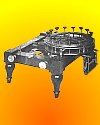 (source)
(source)
|
Charles Thurber
(2 Jan 1803 - 7 Nov 1886)
American inventor of a Printing Machine, an early form of typewriter.
|

Thurber’s Chirographer.

from Scientific American (1847)
We some month’s since noticed Mr. Thurber’s very ingenious machine for writing or forming letters by means of a series of keys which are operated like the keys of an organ. As the inventor’s claim in this invention may be interesting to some of our readers, we give it an insertion. The patentee says—“The nature of my invention consists in communicating to a pen or pencil holder, the motions necessary to delineate any and all letters or other characters, by motions at right angles to each other, obtained by sets of cams, each set being so formed as to combine the right angle movements, and thus generate the vertical, horizontal, oblique, and curved lines required to delineate the letters or characters. Each set of cams is actuated by a separate or distinct lever or handle, as in a piano forte, and the table, with the paper, &c., caused to move for ward the required distance at the termination of each letter or character by the return motion of the lever or handle.
Claim—“Having pointed out the principle of my invention, and the manner of constructing and using the same, and indicated some of the variations in construction, which may be made without changing the principle or character which distinguishes it from all other things before known, what I claim as my invention, and desire to secure by letters patent is communicating the motions to the pen or pencil by means of cams acting on frames, so that the vertical and horizontal strokes can be given by separate movements, and the oblique curved strokes by the combined action of the two, substantially as herein described. And I also claim giving to the sheet of paper, or other substance to be written upon, a horizontal movement for spacing off the letters, and a vertical movement for the lines, in combination with the movements of the pen or pencil, substantially as herein described.”
- 2 Jan - short biography, births, deaths and events on date of Thurber's birth.
- More for Charles Thurber on Today in Science History page.
- Charles Thurber - Printing Machine (Typewriter) Patent No. 3228 - Brief Descriptions.
- Large picture of Charles Thurber Printing Machine (1000 x 700 px)
- Thurber’s First Patent - Text and images from Patent No. 3,228.
- 26 Aug - event description for date Patent No. 3228 (issued 26 Aug 1843), and other events.
- Typewriter Quotes - Today in Science History




